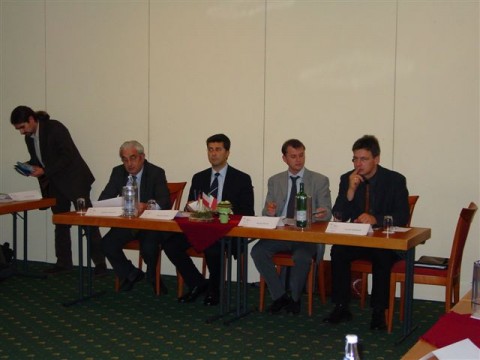EU-Project "Integrated Management of Wetlands" (WETLANDS 2)
The aim of the EU INTERREG III B CADSES, WETLANDS II Project was an integrated management approach for a sustainable ecological and social-economic development of European wetlands. Exchange of knowledge and experience on an international level was to improve communication, public relations work and marketing. These objectives were to be achieved through individual projects.
The project partners were:
- Ente Parco Regionale Veneto del Delta del Po (Italy), (Lead Partner)
- Regione Puglia – Assessorato all’Ambiente – Ufficio Parchi eRiserve Naturali (Italy)
- Elbe River Landscapes Biosphere Reserve (Germany)
- Parco Regionale del Delta del Po dell’Emilia-Romagna (Italy)
- Association for Nature Protection of the Stobrawa Landscape Park “BIOS” (Poland)
- TEULEDA-Local Economic Development Agency of Shkodra (Albania).
The lead partner, Ente Parco Regionale Veneto del Delta del Po (Italy), was applicant and primary grant recipient of the EU funding. This project had already been presented by the Federal Ministry of Transport, Building and Urban Development as a model project for Germany at the Transnational Applicants’ Workshop on 5 May 2003. Up to 75% of the funding was granted by the EU to EU countries under the stipulation that pre-financing and 25% be secured by each individual project partner. The total budget of the project for all partners was 1,893,000 euros. The administration of Elbe River Landscapes Biosphere Reserve took part in this international project with five subprojects from 2003 to 2005. The budget for Elbe River Landscapes Biosphere Reserve was 296,000 euros. Project meetings in Germany for Elbe River Landscapes Biosphere Reserve took place at Wörlitz in 2003 and at Tangermünde in 2004.
The individual projects organised by the administration of the biosphere reserve
1. Public relations work on alternative grassland usage in the northern part of the biosphere reserve
Forms of marketing, such as consultations, conferences and excursions to selected locations, and the publishing of the findings of these conferences in flyers, conference reports, newspapers and on the Internet. This public relations work was needed due to the decline in milk production and the conversion of the grazing cattle to barn cattle which resulted in an overproduction of hay that could no longer be sold. Alternative ways of using grasslands were sought, for example in nature conservation and energy production.
2. Public relations work on finding ways to create near-nature structures along the Havel
The Havel is the most important tributary of the Elbe in the northern part of the biosphere reserve. At the same time it is a dedicated federal waterway, however it is seldom used for commercial shipping.
On 5 September 1996 the federal government signed the “Elbe Declaration” declaring its willingness to stop using the lower Havel Waterway as a though-traffic transport route for freight navigation as soon as the transport project Deutsche Einheit Nr. 17 was completed (the upgrading of the canals between Magdeburg and Brandenburg including the trough bridge over the Elbe). There were already plans to use appropriate measures to restore the Havel which was currently open to commercial shipping. In order to sufficiently inform those affected in the region, special events, information on the state of planning, a travelling exhibit on possible individual projects, excursions to the regions and a website were organized.
3. Accompanying public relations work for two regional measures and planning and establishment of four floodplain nature trails in the northern section of the biosphere reserve
Public relations work was carried out for two measures in the northern section of the biosphere reserve: moving back the Sandau Nord dyke and the re-wetting of a wetland in the Aland lowlands near the town of Wahrenberg. Furthermore the establishment of four nature trails in the northern half of the biosphere reserve were planned. The topics of the trails were to be the Havel Lowlands, storks on the Elbe Valley Floodplain (stork village in Wahrenberg), grassland use on the biosphere reserve near Beuster and Calberwisch and the Elbe’s fluvial dynamics near Magdeburg.
4. Continued development of existing environmental education, extending the Auenhaus into an educational centre
Plans were to turn the Auenhaus, an already existing information centre, into an informational centre for children and pupils on the subjects of sustainable land use, farming, organic farming, gene resources – such as breeding old varieties and wild field herbs - and practical gardening. There were also plans to turn the garden into a qualified educational garden. The plans to extend the Auenhaus into an educational centre also included a seminar room for school classes with audio-visual equipment.
5. Public relations work to connect the UNESCO World Heritage Site Dessau-Wörlitz Garden Realm with UNESCO’s Elbe River Landscapes Biosphere Reserve
This project was to improve the public relations work for the UNESCO World Heritage Site Dessau-Wörlitz Garden Realm. Since 1990 it had been a declared goal of the UNESCO biosphere reserve to protect and conserve the historical cultural landscape of the Garden Realm, which had been located within the borders of the biosphere reserve since 1988. In order to find wide acceptance and to increase the Garden Realm’s name recognition, public relations tools were used such as the creation of flyers, a website for the Garden Realm and outdoor information boards.





